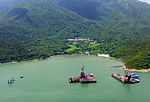Cathay Pacific Flight 780

Cathay Pacific Flight 780 was a flight from Juanda International Airport in Surabaya, Indonesia, to Hong Kong International Airport on 13 April 2010. On board were 309 passengers and a crew of 13. As Flight 780 neared Hong Kong, the crew were unable to change the thrust output of the engines. The aircraft, an Airbus A330-342, landed at almost twice the speed of a normal landing, suffering minor damage. The 57 passengers who sustained injuries were hurt in the ensuing slide evacuation; one of them received serious injuries.The cause of the accident was contamination of the fuel taken on board at Surabaya, which gradually damaged both engines of the aircraft.The flight's two Australian pilots, Captain Malcolm Waters and First Officer David Hayhoe, who safely landed the aircraft despite the extraordinary challenge, have been compared to pilots Chesley Sullenberger and Jeffrey Skiles of US Airways Flight 1549 the previous year (January 2009). In March 2014, the two Flight 780 pilots were awarded the Polaris Award by the International Federation of Air Line Pilots' Associations for their heroism and airmanship.Captain Waters, who was 35 years old, had been working for Cathay Pacific for 12 years, while 37-year-old Hayhoe had been working for Cathay Pacific for 3 years and had previously served with the Royal Australian Air Force for 11 years.
Excerpt from the Wikipedia article Cathay Pacific Flight 780 (License: CC BY-SA 3.0, Authors, Images).Cathay Pacific Flight 780
Hong Kong-Zhuhai-Macao Bridge Hong Kong Link Road, Islands District Chek Lap Kok
Geographical coordinates (GPS) Address Nearby Places Show on map
Geographical coordinates (GPS)
| Latitude | Longitude |
|---|---|
| N 22.308888888889 ° | E 113.91444444444 ° |
Address
香港國際機場 Hong Kong International Airport (赤鱲角機場 Chek Lap Kok Airport)
Hong Kong-Zhuhai-Macao Bridge Hong Kong Link Road
Islands District, Chek Lap Kok
Hong Kong, China
Open on Google Maps










